Yarra Pygmy Perch
Yarra Pygmy PerchNannoperca obscura | |
|---|---|
| Kingdom: | Animalia |
| Phylum: | Chordata |
| Class: | Actinopterygii |
| Order: | Perciformes |
| Sub Order: | Insert sub order here |
| Family: | Percichthyidae (Nannopercidae) |
| Status | |
| World: | Endangered (IUCN 2025) |
| Australia: | Endangered (EPBC Act 1999) |
| Victoria: | Vulnerable (FFG Threatened List 2025) |
| South Australia: | Critically endangered (Action Plan for South Australian Freshwater Fishes 2009) |
| Victorian FFG: | Action Statement No. 134 |
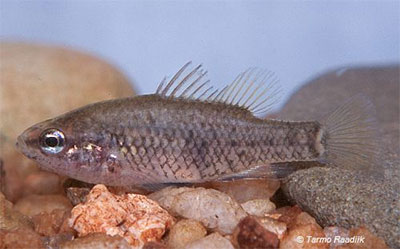
The Yarra Pygmy Perch is a small freshwater fish only found in a limited area of south-eastern mainland Australia. Its name is derived from its early discovery in the Yarra River near Melbourne.
Yarra Pygmy Perch was first described by Klunzinger in 1872 and was regarded as being a member of the Family Kuhliidae ‘Pigmy Perches’, it was assigned the scientific name Edelia obscura which is used in many older publications (Cadwallader & Backhouse 1983; Merrick & Schmida 1984). More recently it is referred to as being a member of the Percichthyidae Family of fishes or Nannopercidae ‘Pygmy Perches’ which also includes species such as the Southern Pygmy Perch Nannoperca australis and the Variegated Pygmy Perch Nannoperca variegata.
All Pygmy Perches are small oblong shape fish having one dorsal fin with a deep notch and the lateral line divided into two parts. Detailed identification between species of Pygmy Perch includes among other features, the counting of dorsal spines and pectoral rays which is elaborated in Kuiter et al. (1996).
The Yarra Pygmy Perch can reach 75mm, but more commonly ranges from 40-65mm (DEH 2005; Hammer et al. 2010; DE 2015). The body is often brown-grey in colour ranging through to gold and olive green. The fins are transparent or translucent, with a faint golden to black colouring, and the male pelvic fin darkens during the breeding season (Allen et al. 2002; Lintermans 2007; Corangamite CMA 2010). Some basic visual features which distinguish it from the Southern Pygmy Perch are lack of red on fins (Hammer 2001), caudal peduncle (area between end of body and tail fin) often with a dark spot, small mouth, slightly notched black pupil, and high dorsal fin (Cadwallader & Backhouse 1983; Allen et al. 2002; DEH 2005; Lintermans 2007; Corangamite CMA 2010).
Distribution
Yarra Pigmy Perch have been recorded from 42 locations, extending from Dandenong Creek in Victoria through to Lake Alexandrina near the mouth of the Murray River in South Australia.
In Victoria, 34 primary locations have been identified. Many of the older records date back to the 1970’s and could now be considered doubtful due to a significant loss of habitat which has occurred since then. Some sites with older records have been verified in recent years, for example Lake Corangamite and Lake Gnarpurt catchments which were considered doubtful but now considered high priority for their conservation values.
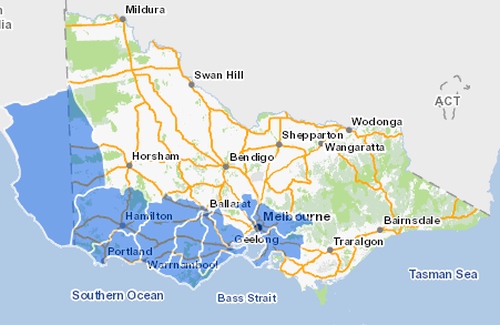
Important Local Government Areas in Victoria for conservation of Yarra Pigmy Perch
CORANGAMITE SHIRE
- Curdies River, Scotts Creek & tributaries
- Floating Islands Flora & Fauna Reserve (Dried out in recent years population most likely extinct)
- Gnarkeet Creek, Corangamite L. (population thought to be extinct until verified in 2017).
- Lake Corangamite Lake Reserve – (significant habitat loss since drought, population most likely extinct).
GLENELG SHIRE
- Bridgewater Lakes (Discovery Bay Coastal Park)
- Crawford River, Regional Park
- Darlot Creek, adjoining private land
- Eumeralla River, adjoining private land
- Fitzroy River, adjoining private land
- Glenelg River, adjoining private land
- Lake Monibeong, Discovery Bay Park
- McRae Creek, Glenelg River catchment, adjoining private land (High priority)
- Merino Creek, Glenelg River catchment, adjoining private land (High priority)
- Miakite Creek, Glenelg River catchment, adjoining private land (High priority)
- Mosquito Creek, Millicent Coast catchment, adjoining private land
- Sunday Creek, Portland Coast, adjoining private land
- Surry River, river flats, adjoining private land
- Wannon River, Glenelg river catchment, adjoining private land (High priority)
- Weerangourt Creek, Portland Coast Catchment, adjoining private land
GOLDEN PLAINS SHIRE
- Woady Yallock River, Streamside Reserve near Pitfield
- Naringal Creek and Kuruc-a-ruc Creek
GREATER DANDENONG CITY
- Dandenong Creek (managed by Melbourne Water and Port Phillip - Westernport CMA)
MACEDON RANGES SHIRE
- Deep creek- Doggets Bridge to Forbes Bridge area, upper Maribyrnong River.
MOYNE SHIRE
- Brucknell Creek, adjoining private land
- Merri River, Hopkins River catchment, adjoining private land
- Spring Creek, Hopkins River Catchment, adjoining private land (High priority)
SOUTHERN GRAMPIANS SHIRE
- Dunkeled, freshwater lake in Upper Wannon catchment, adjoining private land
- Dwyer Creek, Swamp, adjoining private land
- Wannon Falls Scenic Reserve
- Wannon River, Streamside Reserve
SURF COAST SHIRE
- Barwon River (upstream from Pollocksford) – (High priority)
- Pennyroyal Creek, Barwon River catchment, adjoining private land (High priority)
- Thompsons Creek, Otway Coast catchment, adjoining private land (High priority)
- Waurn ponds creek, Barwon River, adjoining private land (High priority)
Ecology & Habitat
The Yarra Pygmy Perch prefers slow-moving or still waters, such as pools in rivers and streams or in lakes. They prefer sites which have abundant submerged and emergent aquatic vegetation, sometimes with wood debris. These characteristics are essential in providing shelter, protection, feeding and breeding habitat (DEH 2005; Lintermans 2007; Hammer et al. 2010;).
Distribution coincides with the alkaline and mineral-rich waterways of the Victorian Volcanic Plains region (Corangamite CMA 2010; DE 2015). Individuals are commonly found in small shoals, in fresh and brackish water, and often co-occur with the Southern Pygmy Perch but are not thought to interbreed (Cadwallader & Backhouse 1983; Lintermans 2007; Hammer et al. 2010).
Spawning
The Yarra Pygmy Perch spawns between September to October, in water temperatures between 16 and 24°C. Males are at least 35mm and females 40mm when they begin breeding and are believed to spawn large, demersal, non-adhesive larvae (DEH 2005; Hammer et al. 2010; DE 2015). Aquatic vegetation provides important habitat for spawning (Jones et al. 2008).
It was previously thought no interbreeding occurred between Southern Pygmy Perch and Yarra Pygmy Perch (Cadwallader & Backhouse 1983; Lintermans 2007; Hammer et al. 2009) but recent genetic data confirms hybridisation to be an issue, particularly in degraded habitats (Hammer et al. 2010; Hammer and Unmack 2010; Unmack et al 2011; Bloink et al. 2017)
Genetic Structure
Studies have found a strong population genetic structure with a minimum of 11 Management Units (MUs) which are nested within four major genetic lineages or Evolutionarily Significant Units (ESUs) (Brauer et al 2013).
Movement
Yarra Pygmy Perch do not readily migrate, they are considered a sedentary species. Due to limited dispersal, morphology varies across their wide distribution, which has led to the potential for subspecies classification (Allen et al. 2002; Hammer et al. 2010).
Growth
Yarra Pygmy Perch have been observed to have a slow growth rate, reaching only 15mm at five months in captivity (DE 2015). Theyare thought to have a lifespan not exceeding 4 years, with the majority of individuals in a population found to be 1-2 years old (Hammer et al. 2010; DE 2015).
Diet
Yarra Pygmy Perch are carnivorous, diet consists of planktonic crustaceans such as copepods and macroinvertebrates. They also feed on insects, mosquito larvae and molluscs (DEH 2005; Lintermans 2007; Jones et al. 2008).
Threats
The Yarra Pygmy Perch has suffered a decline in its populations since being recorded in the 1800’s but particularly since the 1970’s when a more accurate understanding of its distribution was gained. This reduction is broadly attributed to loss or degradation of habitat and introduced predator fish.
As populations are now extremely localised, known threats are of greater concern (Lintermans 2007; Jones et al. 2008).
Damage to Riparian Zones
In many areas riparian vegetation has been cleared, bank erosion has occurred and sedimentation has increased damaging aquatic vegetation, reducing Yarra Pygmy Perch habitat (loss of shelter and breeding habitat, loss of feeding habitat through loss of habitat supporting macro invertebrates).
Wetlands and riparian zones which contain Yarra Pygmy Perch are highly susceptible to degradation from livestock (Crook et al. 2008).
Habitat Fragmentation
In recent years surveys at previously known sites have revealed there are many sites which no longer contain Yarra Pygmy Perch. Remaining populations have become fragmented as changes in water regimes (regulated water flows, water extraction, barriers, reduced flooding) prevent repopulation of areas.
Alteration of Water Flow
Populations of Yarra Pygmy Perch have been affected in recent times by drought, which has reduced flow to many waterways, in some instances creating a series of isolated pools and completely drying out others (Jones et al. 2008). Drought conditions can also result in increased salinity. Coupled with anthropogenic alterations such as dams, transformed channels, water extraction and wetland drainage, the hydrological regime of waterways has been affected (DEWHA 2010; Hammer et al. 2010; Jones et al. 2008). The reduced flow has resulted in poor water quality in many sites and lower water levels have made this species vulnerable to predators (DEH 2005; Jones et al. 2008).
Introduced Species
The Yarra Pygmy Perch is subject to predation and competition by Brown Trout and Redfin. Where European Carp are present they degrade Yarra Pygmy Perch habitat through destruction of aquatic vegetation leading to increased turbidity and loss of suitable feeding and spawning habitat.
Non-native vegetation such as willows can impact on Yarra Pygmy Perch habitat through reduced water flows or reduced levels in pools during dry conditions. Willows can also result in reduced aquatic vegetation (by screening out sunlight) and degrade quality of instream habitat such as loss of woody debris, complex substrates and loss of native vegetation leaf fall which forms an important part of the food chain of macro-invertebrates.
Reduced Water Quality
Salinity- elevated salinity levels have been found at many Victorian sites where records of the Yarra pygmy perch exist (Jones et al. 2008). Keeping salinity below 20,000 EC is a target set for some Yarra Pygmy Perch streams in the Corangamite Catchment (see actions).
Nutrients – agricultural runoff containing fertilizers can increase the likelihood of algal blooms which can increase water temperatures and create low dissolved oxygen conditions beyond the survival tolerance of Yarra Pygmy Perch.
Instream Barriers to Fish Movement
Many dams, locks, fords, culverts and weirs have been constructed which fragment populations (Jones et al. 2008). These barriers prevent migration, which creates a greater likelihood of localised species becoming extinct, and creates sub-populations with lack of genetic diversity (DEH 2005; Jones et al. 2008; Corangamite CMA 2010).
Land use change
Urbanisation of areas near streams which support populations of Yarra Pygmy Perch threaten water quality, instream and riparian habitat. Impacts from urban stormwater runoff containing chemical pollution requires management and monitoring. This issue is particularly relevant for several important sites near Geelong e.g. Thompsons Creek and the Dandenong Creek in Melbourne. In rural settings, intensification of agricultural practices and plantations can pose a threat by reducing water flows and degrading riparian and instream habitat. Although there are cases where improvements to riparian protection have been undertaken in plantation design.
Hybridisation
This issue of hybridisation between Yarra Pygmy Perch and Southern Pygmy Perch has received greater importance as the incidence of detecting hybrids has increased in many waters, particularly where habitats have become degraded.
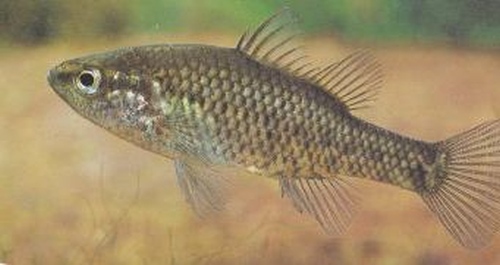
Conservation & Management
The conservation status of Yarra Pygmy Perch was revised from Vulnerable to Endangered on the IUCN Red List in 2019 (Wagner 1996, IUCN 2025). The conservation status was also raised from Vulnerable to Endangered under the EPBC Act 1999 in November 2023 (DCCEEW 2025).
In Victoria, the conservation status was revised from Near Threatened to Vulnerable in 2013 where it has remained (DELWP 2013).
The Department of Energy, Environment and Climate Action (DEECA) is the primary agency for overall management, research and monitoring of the Yarra Pygmy Perch in Victoria. This work is primarily undertaken by the Arthur Rylah Institute for Environmental Research, Riverine & estuarine ecology program.
Catchment Management Authorities contribute to conservation of the Yarra Pygmy Perch through their waterway programs by undertaking protection and restoration of key habitats in conjunction with landholders. Key CMA's for Yarra Pygmy Perch are; Glenelg Hopkins CMA, Corangamite CMA and Port Philip Westernport CMA.
Nature Glenelg Trust undertakes conservation activities in South Australia and some waters in south west Victoria.
Melbourne Water is involved with habitat management in the Dandenong Creek.
Local Government can contribute to conservation of Yarra Pygmy Perch through land planning and management of water runoff from streets and unsealed roads which flow into Yarra Pygmy Perch habitat.
Landholders can contribute to conservation of Yarra Pygmy Perch by reducing agricultural runoff impacts and encouraging native riparian vegetation along waterways.
Genetic studies have found distinct genetic linages which have been grouped into specific management units. It is therefore important that populations of Yarra Pygmy Perch be managed at a catchment level to avoid further losses and restore habitat.
Specific Activities
The DEECA has identified 34 priority locations in Victoria.
- Investigate the feasibility of establishing captive breeding populations with a view to re-establishing populations in the wild from their most appropriate genetic stock.
- Assess the genetic and evolutionary implications of isolated populations to establish whether the current distribution is a response to recent fragmentation as a result of anthropogenic effects or a natural phenomenon.
- Conduct genetic analysis of existing populations to determine stock structuring. Results can be used to determine appropriate re-stocking protocols for maintenance of genetic biodiversity.
- Ensure that non-native or non-indigenous fish are not stocked into waters which are likely to impact upon populations of Yarra Pigmy Perch.
- Undertake regular population monitoring, some sites annually, others every 3-5 years.
- Undertake translocations to establish new populations e.g. Deep creek in upper Maribyrnong River catchment and Dandenong Creek (Melbourne Water is the primary manager of the Dandenong Creek project)
Significant Fish Species Protection under Dry Inflow Conditions Report
This report was produced in 2009 by the Arthur Rylah Institute for Environmental Research (Saddlier, Ryan and Woolley, 2009) for the Corangamite CMA. In response to the report the Corangamite Catchment Management Authority (CCMA) has developed the HERO Significant Fish Project which aims to ensure the survival of the four threatened fish species known to occur in the Corangamite region (one of these being the Yarra Pygmy Perch), the Corangamite CMA has developed three reports which address conservation of this species.
Water Quality Monitoring Plan - the CCMA will track trends in water quality at specific strategic sites to maintain water quality at levels that are tolerable for threatened fish species.
- Weekly monitoring by WaterWatch volunteers at Yarra Pygmy Perch sites: Curdies River, Woady Yallock Creek at Cressy, Thompsons Creek at Rices Reserve (Horseshoe Bend) and Pennyroyal Creek.
- Permanent water quality monitoring station on Thompsons Creek.
- Emergency monitoring by Corangamite CMA River Health Planning staff as required at Yarra Pygmy Perch sites on Thompson Creek and Waurn Ponds Creek as part of the Emergency Response Action Plan.
Long Term Resilience Works Action Plan – the CCMA has documented actions at specific sites to promote resilience and the survival of threatened fish species such as the Yarra Pygmy Perch. Actions include riparian zone fencing and revegetation to improve instream habitat at;
- Curdies River
- Sutherlands Creek
- Woady Yallock Creek at Cressy
- Thompsons Creek x 2 sites
- Pennyroyal Creek
- Waurn Ponds Creek at Grovedale
- Barwon River at Pollocksford
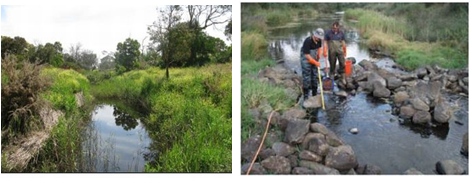
Pilot Emergency Response Action Plan - the CCMA aims to protect remnant habitat pools in priority waterways and populations of significant fish species e.g. Yarra Pygmy Perch at two locations in Thompsons Creek and two locations in Waurn Ponds Creek during critical drought conditions.
- Set water quality and depth trigger levels which are required for survival
- Salinity ≥ 20,000 EC (Yarra Pygmy Perch) Temperature ≥ 28ºC
- Depth ≤ 30cm2
- Dissolved Oxygen (DO) ≤ 4mg/L when depth is between 30cm and 1m3
- if necessary undertake emergency sand bagging to retain water
- if necessary provide additional water to maintain survival pools
Glenelg Hopkins Waterway Strategy 2014-2022, prepared by the Glenelg Hopkins Catchment Management Authority (GHCMA) sets priorities for rehabilitation of streams. On-ground protection and restoration works includes fencing of riparian areas and revegetation where necessary.
- Important sites on the Glenelg, Fitzroy and Wannon rivers and Brucknell Creek are covered in the Plan.
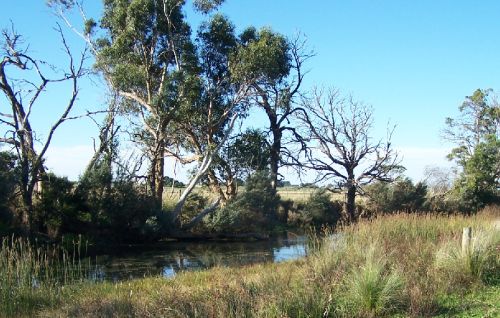
Large scale river restoration project This project commenced in 2010/11 by GHCMA in the upper Glenelg and followed by Rivers of Warrnambool Flagship Project. This will encompass several streams which have been identified as being important Yarra Pygmy Perch sites. This project aims to protect river health along the Glenelg River and inward streams from Rocklands Reservoir to the Wannon River. Each year the project will focus on a section of the River, progressively moving from upstream to downstream.
Victorian environmental partnerships program monitoring
Deep Creek, Doggets Bridge to Forbes Bridge area in the upper Maribyrnong River. A total of 17 waterholes were surveyed for Yarra Pygmy perch. These waterholes were within and just outside the known historical distribution for the species in Deep Creek. A total of 16 individual were recorded from 5 survey locations, which is a decrease from previous surveys.
Opportunities for captive breeding and release
A good example of community involvement in Yarra Pygmy Perch recovery is the project managed by Glenelg Nature Trust. A special translocation project has been established to reintroduce Yarra Pygmy Perch into Pick Swamp. This project involves captive breeding in an aquaculture facility and release through involvement of schools at Millicent High School and Kingston Community School. See video conference notes.
References & Links
Action Plan for South Australian Freshwater Fishes (2009) Michael Hammer , Scotte Wedderburn and Jason van Weenen, Native Fish Australia (SA), Department for Environment and Heritage. pdf.
Allen G. R., Midgley S. H. and Allen M. (2002) Field guide to the freshwater fishes of Australia. Western Australian Museum, Perth, W.A.
Bloink C., Saddlier, S., & Stevenson. K. (2017) Summary Report: Targeted Yarra Pygmy Perch survey of selected waterways in the Lake Corangamite and Lake Gnarpurt catchments, Report prepared for Corangamite Catchment Management Authority by Ecology Australia Pty Ltd.
Brauer, C., Unmack,P., Hammer, M., Adams, M. & Beheregaray, L. (2013) Catchment-Scale Conservation Units Identified for the Threatened Yarra Pygmy Perch (Nannoperca obscura) in Highly Modified River Systems PLoS ONE8(12): e82953. https://doi.org/10.1371/journal.pone.0082953
Cadwallader, P.L., & Backhouse, G.N. (1983) A guide to the freshwater fish of Victoria, Victorian Government Printing Office on behalf of the Ministry for Conservation, Victoria, Australia.
Corangamite CMA (2010) Yarra Pygmy Perch Factsheet. Corangamite Catchment Management Authority, Colac, Victoria.
Crook, D., Macdonald, J., Belcher, C., O’Mahony, D., Dawson, D., Lovett, D., Walker, A., and Bannam, L. (2008) Lake Condah Restoration Project – Biodiversity Assessment. Arthur Rylah Institute for Environmental Research Technical Report Series No. 180, Department of Sustainability and Environment, Heidelberg, Victoria.
Department for Environment and Heritage (DEH) (2005) Adelaide and Mount Lofty Ranges South Australia threatened species profile – Yarra pygmy perch. Department for Environment and Heritage, Adelaide, South Australia.
DELWP (2013) Advisory List of Threatened Vertebrate Fauna in Victoria – 2013. Department of Environment, Land, Water & Planning, Victoria.
DCCEEW (2015) Nannoperca obscura in Species Profile and Threats Database Department of Climate Change, Environment, Energy and Water, Department of the Environment, Canberra. Viewed 5 May 2025.
FFG Threatened List (2025) Flora and Fauna Guarantee Threatened List, March 2025, Department of Energy, Environment and Climate Action, Victoria (DEECA).
Hammer M. (2001) Freshwater Fishes of South Australia, Data Sheet, Native Fish Australia (SA) Inc.
Hammer, M., Unmack, P., Adams, M., Johnson, J., & Walker, K. (2010). Phylogeographic structure in the threatened Yarra pygmy perchNannoperca obscura (Teleostei: Percichthyidae) has major implications for declining populations. Conservation Genetics, 11, 213-223. DOI: 10.1007/s10592-009-0024-9
IUCN (2025) Whiterod, N., Hammer, M., Raadik, T., Coleman, R., Wedderburn, S.D., Veale, L. & Saddlier, S. 2019. Nannoperca obscura. The IUCN Red List of Threatened Species 2019: https://dx.doi.org/10.2305/IUCN.UK.2019-3.RLTS.T39301A123379189.en. Accessed on 02 May 2025.
Jones, M., Tinkler, P., Lindeman, M., Hackett, G., and Pickworth, A. (2008) Threats, distribution and abundance of Yarra Pygmy Perch in Victoria during a drought period. Arthur Rylah Institute for Environmental Research Technical Report Series No. 184, Department of Sustainability and Environment, Heidelberg, Victoria.
Kuiter, R.H., Humpheries, P., Arthington, A.H. (1996) Pygmy Perch. In; Freshwater Fishes of South-Eastern Australia, Ed. McDowall, R.M., pp168-175. Reed Books: Sydney.
Lintermans M. (2007) Fishes of the Murray-Darling Basin : an introductory guide. Murray-Darling Basin Commission, Canberra, ACT.
Merrick, J.R., & Schmida, G.E. (1984) Australian Freshwater Fishes, biology and management, School of Biological Sciences, Macquarie University, NSW, Australia. Griffin Press Limited, Netley, South Australia.
Unmack, P. J., Hammer, M., Adams, M., and Dowling, T. E. 2011. A phylogenetic analysis of pygmy perches (Teleostei: Percichthyidae) with an assessment of the major historical influences on aquatic biogeography in southern Australia. Systematic Biology 60: 797–812. Abstract NCIB
Saddlier, S, and Hammer, M. (2010) National Recovery Plan for the Yarra Pygmy Perch Nannoperca obscura. Department of Sustainability and Environment, Melbourne, Victoria.
VBA (2025) Victorian Biodiversity Atlas, Department of Energy, Environment and Climate Action, Victoria (DEECA).
Wager, R. (1996) Nannoperca obscura. The IUCN Red List of Threatened Species 1996.

